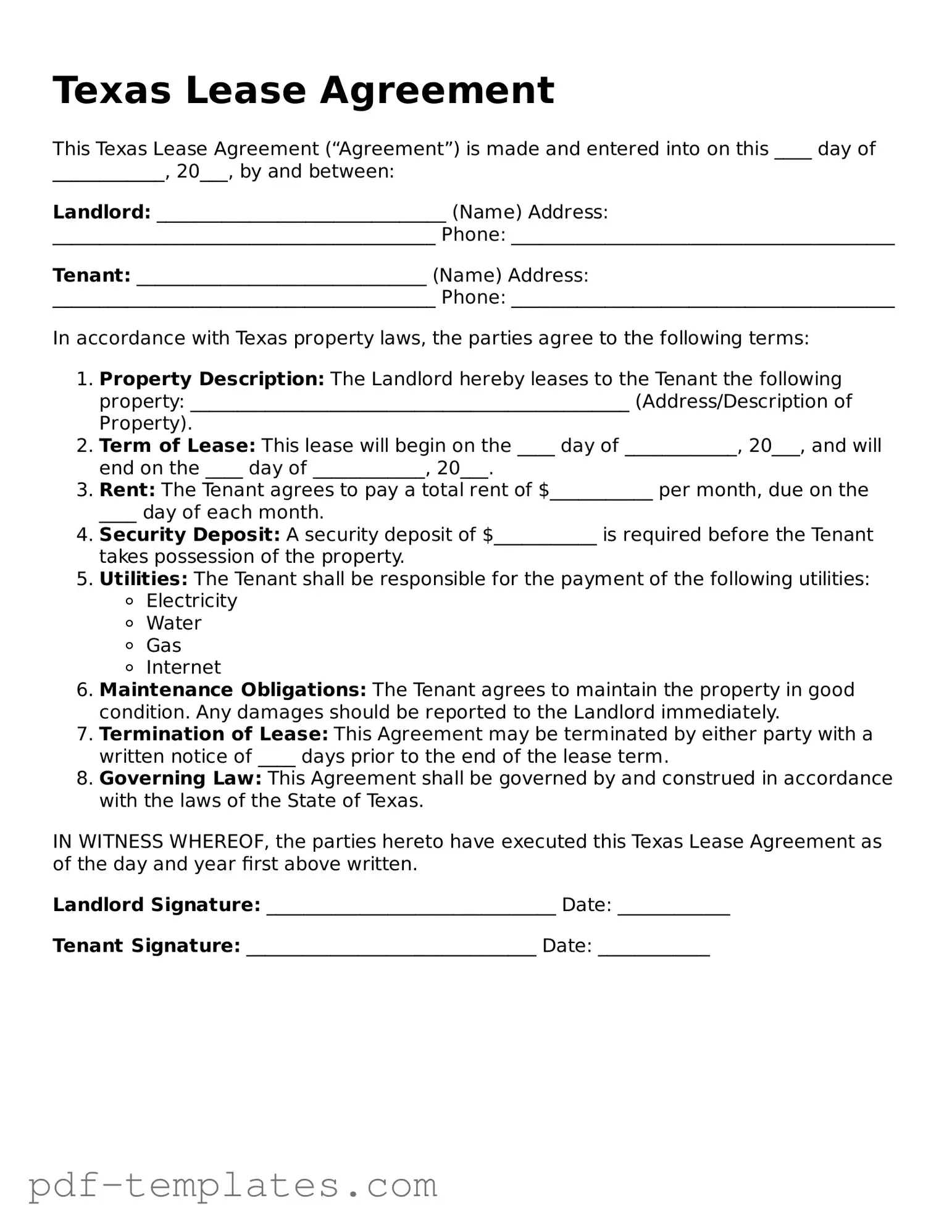The Texas Lease Agreement form shares similarities with the Residential Lease Agreement, which is commonly used across the United States. Both documents outline the terms under which a landlord allows a tenant to occupy a property. Key components, such as rental payment amounts, lease duration, and responsibilities for maintenance, are typically included in both agreements. The Residential Lease Agreement can vary by state, but its fundamental purpose remains consistent: to protect the rights of both landlords and tenants while ensuring a clear understanding of the rental terms.
Another document akin to the Texas Lease Agreement is the Commercial Lease Agreement. This type of lease is designed for businesses renting commercial properties. While the Texas Lease Agreement focuses on residential properties, both documents detail similar elements, such as the duration of the lease, payment terms, and the obligations of both parties. However, a Commercial Lease Agreement often includes additional provisions related to business operations, zoning laws, and modifications to the property, reflecting the different needs of commercial tenants.
The Rental Application form is also comparable to the Texas Lease Agreement, as both are integral parts of the rental process. A Rental Application is typically completed by prospective tenants and serves to gather essential information, such as employment history and creditworthiness. This document informs the landlord's decision to enter into a lease agreement. Once a tenant is approved, the Texas Lease Agreement formalizes the arrangement, providing a comprehensive outline of the rights and responsibilities that the tenant and landlord will uphold.
Similar to the Texas Lease Agreement is the Month-to-Month Lease Agreement. This type of lease offers flexibility, allowing tenants to rent a property on a month-to-month basis without a long-term commitment. Both agreements will include essential terms such as rent amount and notice periods for termination. However, a Month-to-Month Lease Agreement often provides a simpler framework, as it can be modified or terminated with relatively short notice, making it suitable for individuals seeking temporary housing arrangements.
For those interested in transactions involving mobile homes, understanding the nuances of a "complete Mobile Home Bill of Sale guide" is vital. This form serves as a safeguard, detailing the specifics of the sale and ensuring that all legal requirements are met. To access the form, visit the comprehensive Mobile Home Bill of Sale webpage.
The Sublease Agreement is another document that aligns with the Texas Lease Agreement. A Sublease Agreement allows a tenant to lease a portion or all of the rental property to another individual, known as the subtenant. Both agreements outline rental terms, responsibilities, and rights, but the Sublease Agreement also addresses the relationship between the original tenant and the subtenant. It is essential for the original tenant to ensure that the sublease complies with the terms of the Texas Lease Agreement, as unauthorized subletting can lead to legal complications.
The Lease Addendum is a document that complements the Texas Lease Agreement by adding specific terms or conditions to the original lease. This might include pet policies, additional fees, or alterations to the property. Both the Lease Addendum and the Texas Lease Agreement must be mutually agreed upon by both parties to be enforceable. The Addendum serves to clarify or expand upon the original lease terms, ensuring that both the landlord and tenant have a mutual understanding of any additional stipulations.
The Lease Termination Agreement is also relevant, as it outlines the process for ending a lease before its designated expiration. While the Texas Lease Agreement establishes the initial terms of the lease, the Termination Agreement provides a formal mechanism for both parties to agree to conclude the rental relationship. This document may specify the conditions under which the lease can be terminated, notice requirements, and any obligations related to property return and security deposit refunds.
Lastly, the Rental Receipt is similar in that it serves as proof of payment for rent, which is a critical aspect of the Texas Lease Agreement. This document confirms that the tenant has paid the agreed-upon rent amount and can help prevent disputes regarding payment history. While the Rental Receipt is not a lease agreement itself, it is an important record that supports the terms outlined in the Texas Lease Agreement, reinforcing the financial obligations of the tenant.
